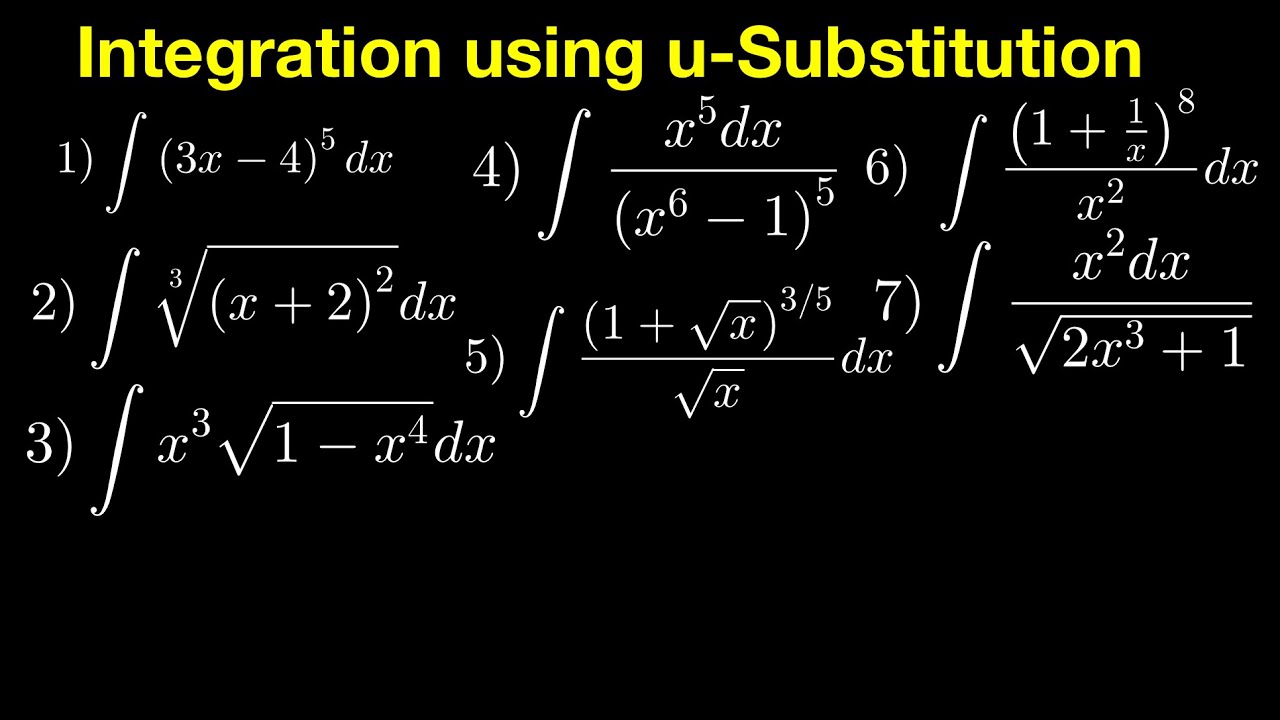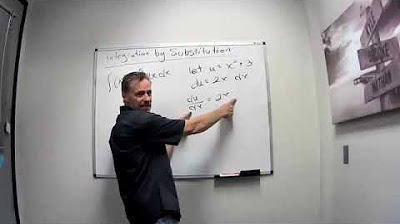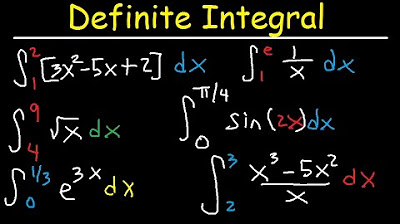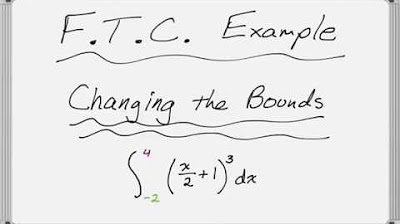Calculus AB Homework 6.7 U-Substitution
TLDRIn this video, we solve unit six homework problems 56 through 64, focusing on integration using u-substitution. The instructor guides viewers through each problem, demonstrating step-by-step how to integrate functions like x^3 * (x^4 + 3)^3, x * √(1 + 2x^2), and more. The detailed explanations cover finding the appropriate substitution, rewriting the integral, and integrating using the power rule. By the end, viewers will understand how to approach and solve various integration problems using u-substitution.
Takeaways
- 📚 The video covers the integration of various functions using substitution method for homework problems 56 to 64.
- 🔍 Problem 56 involves integrating a function with x and a polynomial, where u is set to x^4 + 3, and the integral is simplified to 1/16 * (x^4 + 3)^4 + C.
- 📈 Problem 57 demonstrates the integration of a function with a cube root, where u is set to 1 + 2x^2, leading to an integral of 3/16 * (1 + 2x^2)^(4/3) + C.
- 🌀 Problem 58 shows the integration of a function with sine and a power of x, where u is x^4, resulting in an integral of -1/4 * cos(u) + C, and then substituting back for x.
- 🔑 Problem 59 involves a rational function integration, where u is 1 + x^4, and the integral simplifies to -1/4 * (1 + x^4)^(-2) + C.
- 🛣️ Problem 60 deals with the integration of a function involving a square root and a polynomial, where u is 1 - x^2, leading to an integral of -5/3 * (1 - x^2)^(3/2) + C.
- 🎢 Problem 61 is about integrating a function with a square root and a cubic polynomial, where X is set to u^3 + 2, resulting in an integral of 2/9 * (u^3 + 2)^(3/2) + C.
- 🌐 Problem 62 involves the integration of a function with a square root and a linear term, where u is 2x - 1, leading to an integral of (1/5) * (2x - 1)^(5/2) + (2/3) * (2x - 1)^(3/2) + C.
- 🔄 Problem 63 is about integrating a function with a square root and a linear term, where u is 2 - x, and the integral is simplified to -2 * (2 - x)^(3/2) - (2/5) * (2 - x)^(5/2) + C.
- 📉 Problem 64 is a definite integral from 1 to 5 of x over the square root of 2x - 1, which is solved by changing the limits of integration according to the substitution u = 2x - 1, resulting in a final answer of 16/3.
Q & A
What is the main topic of this video?
-The main topic of this video is to work through unit six homework problems 56 through 64, which deal with integration using substitution.
What is the first integral problem discussed in the video?
-The first integral problem discussed is to integrate x^3 * (x^4 + 3)^3 with respect to x using substitution.
How does the substitution process start in the first problem?
-The substitution process starts by letting u equal the expression inside the parentheses, which is x^4 + 3, and then finding du/dx to be 4x^3.
What is the purpose of multiplying both sides of the derivative equation by dx in the substitution method?
-Multiplying both sides by dx helps to express du in terms of dx, which is necessary to replace dx in the integral with an equivalent expression in terms of du.
How is the integral of x^3 * (x^4 + 3)^3 simplified in terms of u?
-The integral is simplified by replacing x^3 dx with 1/4 du and rewriting the expression as 1/4 u^3 du, which can then be integrated using the power rule.
What is the final answer for the first integral problem in terms of the original variable x?
-The final answer, after substituting back for u, is 1/16 * (x^4 + 3)^4 + C.
What is the strategy for the integral problem involving the cube root of 1 + 2x^2?
-The strategy is to let u be the expression inside the cube root, 1 + 2x^2, and then find du/dx to be 4x, which is then manipulated to match the dx in the integral.
How is the integral of x * cube root(1 + 2x^2) transformed using substitution?
-The integral is transformed by replacing x dx with 1/4 du and rewriting the expression as 1/4 * u^(1/3), which can be integrated using the power rule.
What is the final form of the integral for problem 58 involving sin(x^4)?
-The final form of the integral is -1/4 cos(u) + C, where u is x^4, after substituting and integrating.
How are the limits of integration adjusted when performing substitution on a definite integral?
-The limits of integration are adjusted by evaluating the new variable u at the original limits of x, which in the case of problem 64, changes from x=1 to u=1 and from x=5 to u=9.
What is the final answer for the definite integral problem 64 from x=1 to x=5 of x / sqrt(2x - 1)?
-The final answer, after evaluating the definite integral and converting back to the original variable x, is approximately 16.666... or 50/3.
Outlines
📘 Integrating Using U-Substitution - Problem 56
In this video, we work through unit six homework problems 56 through 64, focusing on integration using u-substitution. For problem 56, we integrate X cubed times (X to the fourth plus 3) cubed. By letting u equal X to the power 4 plus 3, we find that du/dx equals 4x cubed. Multiplying both sides by dx, we get du equals 4x cubed dx. Dividing both sides by 4, we have 1/4 du equals x cubed dx. Replacing x cubed dx with 1/4 du, the integral becomes 1/4 u cubed du. Using the power rule, we integrate to get 1/16 u to the power 4 plus C. Replacing u with X to the fourth plus 3, the final answer is 1/16 (X to the fourth plus 3) to the power 4 plus C.
📗 Integrating Using U-Substitution - Problem 57
For problem 57, we integrate x times the cube root of 1 plus 2x squared. We let u equal 1 plus 2x squared, so du/dx equals 4x. Multiplying both sides by dx, we get du equals 4x dx. Since the problem has x dx, we divide both sides by 4 to get 1/4 du equals x dx. Replacing x dx with 1/4 du, we rewrite the integral as 1/4 integral of u to the power 1/3 du. Integrating using the power rule, we get 1/4 (3/4 u to the power 4/3) plus C. Replacing u with 1 plus 2x squared, the final answer is 3/16 (1 plus 2x squared) to the power 4/3 plus C.
📙 Integrating Using U-Substitution - Problem 58
For problem 58, we integrate x cubed times sine of X to the fourth. Letting u equal X to the fourth, we find that du/dx equals 4x cubed. Multiplying by dx, we get du equals 4x cubed dx. Dividing by 4, we have 1/4 du equals x cubed dx. Substituting, the integral becomes 1/4 integral of sine u du. The integral of sine is negative cosine, so we get negative 1/4 cosine u plus C. Replacing u with X to the fourth, the final answer is negative 1/4 cosine (X to the fourth) plus C.
📕 Integrating Using U-Substitution - Problem 59
For problem 59, we integrate X cubed over (1 plus X to the fourth) squared. We let u equal 1 plus X to the fourth, so du/dx equals 4x cubed. Multiplying by dx, we get du equals 4x cubed dx. Dividing by 4, we have 1/4 du equals x cubed dx. Replacing, the integral becomes 1/4 integral of 1/u squared du. Recognizing 1/u squared as u to the power -2, we integrate to get negative 1/4 (1/u) plus C. Replacing u with 1 plus X to the fourth, the final answer is negative 1/4 (1/(1 plus X to the fourth)) plus C.
📒 Integrating Using U-Substitution - Problem 60
For problem 60, we integrate 5x times the square root of 1 minus x squared. Letting u equal 1 minus x squared, we find that du/dx equals -2x. Multiplying by dx, we get du equals -2x dx. Dividing by -2, we have -1/2 du equals x dx. Multiplying by 5, we get -5/2 du equals 5x dx. Replacing, the integral becomes -5/2 integral of u to the power 1/2 du. Using the power rule, we get -5/2 (2/3 u to the power 3/2) plus C. Simplifying, we get -5/3 u to the power 3/2 plus C. Replacing u with 1 minus x squared, the final answer is -5/3 (1 minus x squared) to the power 3/2 plus C.
📓 Integrating Using U-Substitution - Problem 61
For problem 61, we integrate u squared times the square root of u cubed plus 2. Since the integral starts with u as the variable, we use a different letter for substitution. Letting x equal u cubed plus 2, we find that dx/du equals 3u squared. Multiplying by du, we get dx equals 3u squared du. Dividing by 3, we have 1/3 dx equals u squared du. Replacing, the integral becomes 1/3 integral of x to the power 1/2 dx. Integrating using the power rule, we get 1/3 (2/3 x to the power 3/2) plus C. Simplifying, we get 2/9 x to the power 3/2 plus C. Replacing x with u cubed plus 2, the final answer is 2/9 (u cubed plus 2) to the power 3/2 plus C.
📔 Integrating Using U-Substitution - Problem 62
For problem 62, we integrate x times the square root of 2x minus 1. Letting u equal 2x minus 1, we find that du/dx equals 2. Multiplying by dx, we get du equals 2 dx. Dividing by 2, we have 1/2 du equals dx. Substituting for dx, we get x times the square root of u times 1/2 du. To eliminate x, we solve u equals 2x minus 1 for x, yielding x equals (u plus 1)/2. Rewriting the integral, we get 1/2 integral of (u plus 1)/2 times the square root of u du. Simplifying and integrating using the power rule, we get 1/4 integral of u to the power 3/2 plus u to the power 1/2 du. Integrating, we get 1/4 (2/5 u to the power 5/2 plus 2/3 u to the power 3/2) plus C. Simplifying, the final answer is 1/10 (2x minus 1) to the power 5/2 plus 1/6 (2x minus 1) to the power 3/2 plus C.
📜 Integrating Using U-Substitution - Problem 63
For problem 63, we integrate x plus 1 times the square root of 2 minus x. Letting u equal 2 minus x, we find that du/dx equals -1. Multiplying by dx, we get du equals -dx. Rewriting, we have the integral of (2 - u + 1) times the square root of u du. Simplifying and integrating using the power rule, we get the integral of (3 - u) times the square root of u du. Distributing and integrating, we get 3u to the power 3/2 times 2/3 minus u to the power 5/2 times 2/5 plus C. Simplifying, the final answer is 2 (2 - x) to the power 3/2 minus 2/5 (2 - x) to the power 5/2 plus C.
📖 Integrating Using U-Substitution - Problem 64
For problem 64, we integrate x over the square root of 2x minus 1 from 1 to 5. Using u equals 2x minus 1, we convert the limits of integration. With u equal to 1 when x is 1 and u equal to 9 when x is 5, we transform the integral to 1/4 integral of u to the power 1/2 plus 1/u to the power 1/2 du. Integrating, we get 1/4 (2/3 u to the power 3/2 plus 2u to the power 1/2) evaluated from 1 to 9. Substituting and simplifying, we find the final answer is 16/3.
Mindmap
Keywords
💡U-substitution
💡Integral
💡Derivative
💡Power Rule
💡Definite Integral
💡Indefinite Integral
💡Bounds of Integration
💡Cube Root
💡Square Root
💡Constant Multiple Rule
Highlights
Introduction to solving unit six homework problems 56 through 64 using substitution method.
Integration of \( x^3 \times (x^4 + 3)^3 \) by setting \( u = x^4 + 3 \) and simplifying the integral.
Rewriting the integral in terms of \( u \) and applying the power rule to find the antiderivative.
Substituting back \( x^4 + 3 \) for \( u \) to get the final answer in terms of \( x \).
Integration of \( x \times \sqrt{1 + 2x^2} \) by setting \( u = 1 + 2x^2 \) and simplifying the integral.
Using power rule to integrate \( \sqrt{u} \) and substituting back to get the final result.
Dealing with the integral of \( x^3 \sin(x^4) \) by setting \( u = x^4 \) and simplifying the integral.
Applying the power rule to integrate \( \sin(u) \) and substituting \( x^4 \) back for \( u \).
Integration of \( x^3 / (1 + x^4)^2 \) by setting \( u = 1 + x^4 \) and adjusting the substitution.
Using the power rule to integrate \( 1/u^2 \) and substituting back to find the final answer.
Solving the integral of \( 5x \sqrt{1 - x^2} \) by setting \( u = 1 - x^2 \) and adjusting the substitution.
Integrating \( \sqrt{u} \) and substituting \( 1 - x^2 \) back for \( u \) to get the final result.
Integration of \( u^2 \sqrt{u^3 + 2} \) by choosing a new variable \( X \) and simplifying the integral.
Applying the power rule to integrate \( \sqrt{X} \) and substituting \( u^3 + 2 \) back for \( X \).
Solving the integral of \( x \sqrt{2x - 1} \) by setting \( u = 2x - 1 \) and dealing with the substitution.
Integrating \( \sqrt{u} \) and substituting \( 2x - 1 \) back for \( u \) to find the final answer.
Integration of \( (x + 1) \sqrt{2 - x} \) by setting \( u = 2 - x \) and simplifying the integral.
Applying the power rule to integrate \( \sqrt{u} \) and substituting \( 2 - x \) back for \( u \).
Solving the definite integral from 1 to 5 of \( x / \sqrt{2x - 1} \) using substitution and adjusting limits.
Calculating the definite integral and verifying the result with a calculator.
Transcripts
5.0 / 5 (0 votes)
Thanks for rating:





